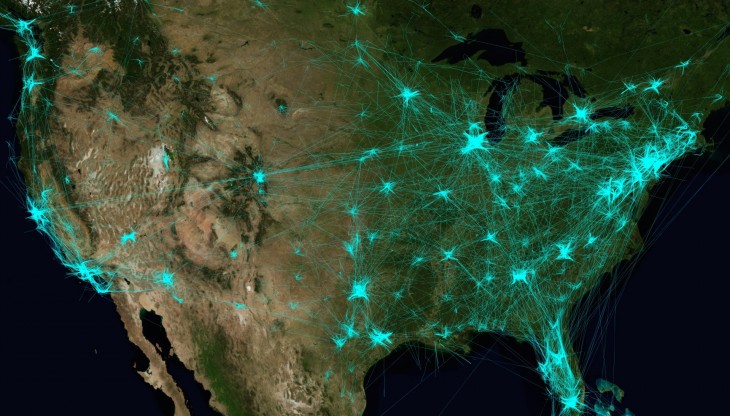
Going global with anything is never an easy task. There are various legal, cultural and resourcing standpoints to consider in order to successfully scale.
While SMS can be straightforward on a local level, going global can be challenging for a number of reasons: various local regulations, inefficient performing routes, untrustworthy aggregators and more.
Traditional telecom infrastructure is cumbersome
The traditional telecom infrastructure was never built to support the volume of business-to-person messaging we’re seeing today. Some companies have resorted to Application-to-person (A2P) SMS, but as we’ve noted before, the process for delivering A2P SMS is clunky and can be expensive to deploy.
Traditional methods require a company to liaise with a variety of middlemen such as SMS aggregators, gateway providers, and resellers before gaining access to the SMS inventory of the various network operators. This alone bumps up the cost to entry, in addition to any specialized telephony hardware and software middlemen prefer to use.
Network operators don’t typically offer A2P SMS services directly to small businesses; for most companies, the only way to go global is to use these middlemen. This then limits the amount of businesses who can send SMS globally to those that are able to afford it.
SMS aggregators are – at times – shady
As there is no way for one party to connect directly to every single telco in the world, the use of SMS aggregators is the most ideal method for a global footprint.
However, there is a possibility that such aggregators might be using what’s commonly known as a “grey route.” A grey route is where a service provider or SMS aggregator sends messages to end-users in another country without paying the recipient’s network for their delivery.
Typically, a telco would charge another telco for sending an SMS to their network if the SMS originated internationally. However, since international SMS was designed for peer-to-peer (P2P) messaging, these fees essentially cancel each other out as you would normally get replies.
In effect, if Telco 1 charged Telco 2 for sending an SMS to their network, Telco 2 would have to charge Telco 1 as well when the recipient replies. Therefore, the telcos often just didn’t charge each other.
To avoid fees, grey routes can be implemented by exploiting an intermediary that has a terminating agreement with the end operator, disguising the origin of the message as a ‘person’ instead of an ‘application,’ or making the message appear to be national as opposed to international.
SMS aggregators using grey routes attract customers by offering cheap rates for delivering bulk SMS and monetize by exploiting gains made from sending messages for free.
Aware of the issue, telcos will often work with aggregators they trust to block grey routes. If your SMS aggregator is using a blocked grey route, you may not be able to monitor if an end recipient is receiving your message.
Presence of local regulations and country-specific guidelines
Every country has different regulations and guidelines for when certain types of messages are allowed to be sent. For example, promotional A2P SMS cannot be delivered in India between 9 PM to 9 AM, and some countries won’t allow you to include a URL within a message.
Before sending messages in a new country, you’ll need to sign a legally binding contract that says you will adhere to these rules at all times (that, or pay a fine of $500 per message).
In addition to country-specific requirements, many carriers have their own unique compliance requirements. Some may filter out specific phrases or words to censor content it deems inappropriate for readers. On average, three carriers around the world change a rule or regulation each week. That’s a lot of rules to keep up with if you’re sending SMS to multiple countries!
Since each country has different compliance regulations, best practice guidelines also have to be tailored per country. For example, in Brazil, a message can only contain 157 characters instead of the standard 160 characters.
In the US, all A2P messaging needs to take place over a short code (five to six-digit) number. These numbers can cost up to $1,500 a month, and the application process takes between 8 to 12 weeks. Therefore, the best practice might mean partnering with a service that provides pre-approved short codes available on a pay-per-use basis.
Keeping up with best practices in each country require a lot of time and effort, making SMS hard to scale globally.
Lack of a direct route from sender to receiver
Sending SMS can be akin to traveling internationally as airlines work on a hub-and-spoke model. The airlines decide what routes they will operate, and you’ll have to take those predetermined routes to get to your destination, either via a direct flight or with several transfers.
Similarly, when an SMS is sent internationally, it will have to travel along predetermined routes. Sometimes, a message may be transferred five to six times to get to its final destination.
The huge amount of transfers involved greatly reduces quality of message delivery, as transferring routes has its own issues. A delay or cancellation in delivery may occur if one route is busy or if there are problems with network connectivity. This is why new cloud-based SMS aggregators like Nexmo offer a 1-hop (transfer) maximum rule to avoid delays and undelivered messages.
What other issues have you come across while trying to scale SMS globally? We’d love to hear from you in the comments.
Read next: Why are people still using SMS in 2015?
Get the TNW newsletter
Get the most important tech news in your inbox each week.
This post is part of a new series titled, 'Future of Communications,' and is brought to you by Nexmo.









